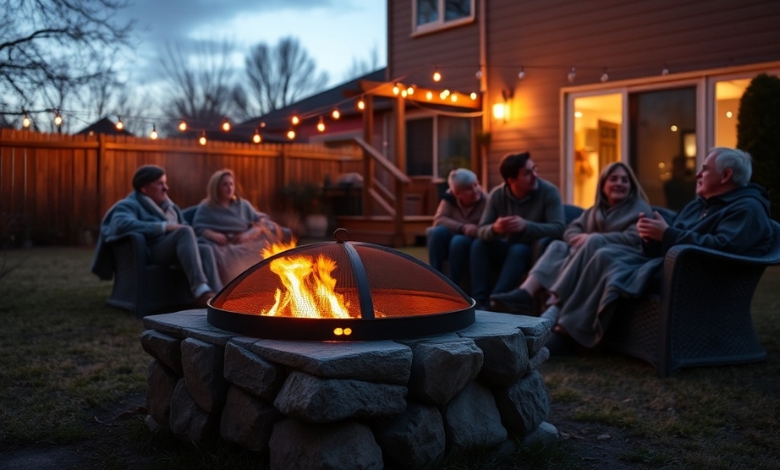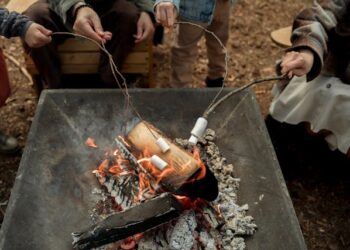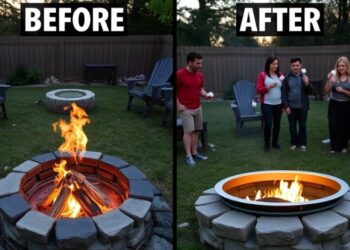Discover how a fire pit heat deflector transforms your backyard nights by enhancing warmth, safety, and fuel efficiency.
We’ve all been there: you gather around the fire pit on a chilly night, expecting comfort and conversation, but end up with your front roasted and your back frozen. You rotate like a rotisserie chicken trying to stay warm. You scoot closer, only to feel like your eyebrows are under threat. That’s the raw deal of direct fire pit heat, uneven, inefficient, and unpredictable.
Enter the fire pit heat deflector. This isn’t just another backyard gadget. It’s the upgrade that turns a basic fire pit into a precision-engineered heat-dispersing machine. Think of it as tuning a drum: it’s all about better distribution, resonance, and control. Except this time, it’s heat you’re fine-tuning, not sound.
What You'll Discover:
What Is a Fire Pit Heat Deflector, Really?
Most people imagine some fancy shield or bulky contraption when they hear the term. But at its core, a fire pit heat deflector is a reflective metal plate, usually stainless steel or aluminum, mounted above the fire to redirect rising heat outward.
Rather than letting all that warmth escape into the void of the sky, the deflector bends that thermal energy horizontally. The result? Toasty vibes all around, not just for whoever lucked out with the wind.
It’s like turning your fire pit from a lighthouse into a heat lamp, focused, intentional, and everyone gets a slice of the warmth pie.
Why Fire Pit Heat Deflectors Are Stealing the Spotlight
Let’s step into the practical side. Why do fire pit heat deflectors matter? The short answer: they change the whole experience. The long answer? Strap in.
Equal Warmth for Everyone
One of the most frustrating things about fire pits is their moody heat distribution. Without a deflector, only the people sitting in the direct path of the heat, or close enough to kiss the flames, get warm.
A deflector smooths out the warmth, radiating it more evenly. Everyone around the circle feels included. No one has to roast one side of their body at a time.
Drastic Fuel Efficiency
Ever burned through logs like a lumberjack on overtime just to stay warm? That’s because most of your fire’s heat is flying into the atmosphere.
A deflector redirects a portion of that upward heat sideways, trapping warmth in the “human zone.” Less fuel, same comfort. Sometimes even better. It’s not magic. It’s thermodynamics used smartly.
Weather-Proof Your Night
Windy evenings can make fire pit use feel like a gamble. One gust and the warmth is gone. A good heat deflector buffers against the wind’s mischief, helping retain and redirect warmth where it’s needed.
And if it’s drizzling or misty? Stainless steel deflectors often double as partial rain guards for your flames.
How It Works: The Science Behind the Warmth
Let’s break this down without going full science textbook.
Fire pits release radiant heat straight upward. That’s just what hot air does, it rises. A heat deflector, positioned strategically above the flame, captures that rising heat and “reflects” it outward in a radial pattern.
Think of it like bouncing light off a mirror. The heat particles hit the metal plate and get rerouted horizontally, bathing the surrounding space in warmth.
The effectiveness of this depends on:
- Material conductivity: Stainless steel is great because it reflects heat without absorbing too much.
- Height above flame: Usually 18–24 inches is ideal for optimal deflection.
- Surface shape: A slightly concave or dome-shaped deflector performs better than a flat one, it directs more heat outward.
Not Just Warmth: The Hidden Perks of Using a Heat Deflector
Enhanced Safety
With a deflector, you don’t need to sit dangerously close to feel warm. That means fewer singed marshmallows, and less chance someone’s scarf or sleeve gets a little too cozy with the flame.
Also, elevated deflectors can prevent errant sparks or embers from flying straight up, especially important in dry areas or fire-prone zones.
Protects What’s Above
Got a covered patio? A pergola? A ceiling fan that probably regrets being installed above a fire pit?
A heat deflector can shield overhead structures from the punishing vertical heat blast. It’s like putting sunglasses on your patio roof, it takes the glare off.
Keeps the Night Going
When temperatures dip unexpectedly, or if your crowd decides to hang around for “just one more drink,” a deflector ensures your fire pit stays an effective warmth source longer. That spontaneous storytelling session under the stars? No one will leave because their feet went numb.
Choosing the Right Fire Pit Heat Deflector
Not all deflectors are created equal. Picking the right one means balancing size, material, shape, and compatibility.
Size Matters (But Not Like You Think)
It doesn’t have to cover the entire fire pit, but it should be wide enough to reflect a generous portion of the heat outward. Typically, a deflector 2–4 inches wider than the pit diameter works best.
Material Choices
- Stainless Steel: Durable, rust-resistant, high heat reflection.
- Aluminum: Lightweight and highly reflective, but more prone to warping.
- Steel with Powder Coating: Visually appealing but can peel under intense heat if poorly made.
Shape and Design
- Flat Panels: Basic, affordable, does the job.
- Domed or Angled: Better at distributing heat in all directions.
- Multi-Panel Designs: Foldable for easy storage, but watch out for gaps where heat escapes.
Compatibility and Mounting
Some deflectors come with universal stands, while others require custom mounts or are only compatible with specific fire pit brands. Always check specs. There’s nothing more frustrating than a heat deflector that doesn’t fit, like trying to wear shoes two sizes too small.
DIY Fire Pit Heat Deflector: Should You Try It?
If you’re handy, you might wonder: “Can I make one myself?” The short answer? Yes. The long answer? Tread carefully.
What You’ll Need
- Stainless steel sheet (16-18 gauge works well)
- Drill and bolts (or welding gear)
- Mounting brackets or tripod stand
- Heat-resistant gloves and eye protection
Design Tips
- Make sure it’s stable. A deflector crashing into your fire is a backyard horror story.
- Keep a safe clearance between the flame and the metal.
- Avoid sharp corners or rough edges.
DIY can save money and offer customization, but if safety or durability is a concern, commercial options are often worth the investment.
Real-Life Test: Does It Actually Make a Difference?
Let’s bring in a real-world angle. A group of backyard enthusiasts ran side-by-side tests with two identical fire pits, one with a heat deflector, one without.
Results:
- The deflector group reported sustained comfort from 6+ feet away.
- Wood consumption was reduced by ~25%.
- One user said: “For the first time, I didn’t have to rotate like a kebab.”
That’s anecdotal, sure, but consistent. And the consistency across users speaks volumes about the practical, tangible impact.
What It Won’t Do (So You Don’t Get Duped)
Let’s get this straight, it’s not a miracle worker.
- It won’t cook your food faster.
- It won’t stop smoke from blowing in your face.
- It won’t make your fire pit safe for enclosed patios unless it’s designed to be.
A heat deflector enhances comfort, not fire safety or cooking capabilities. Keep expectations grounded, and you’ll be pleasantly surprised.
Best Use Practices
- Keep it clean: Soot and ash buildup reduce heat reflectivity.
- Don’t block the flame: Always maintain airflow. Deflect, don’t smother.
- Use with seasoned firewood: Wet wood produces steam and smoke that lessen the deflector’s impact.
Key Takings
- A fire pit heat deflector redirects rising heat outward, offering more even warmth.
- It reduces fuel consumption by keeping warmth closer to the group.
- The right deflector enhances comfort, safety, and efficiency.
- Choose based on size, material, and fire pit compatibility.
- DIY versions are possible but require caution and craftsmanship.
- Real-world use shows significant benefits, especially in colder months or breezy conditions.
- It’s not a catch-all solution, but it is a meaningful upgrade to your outdoor setup.





